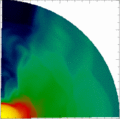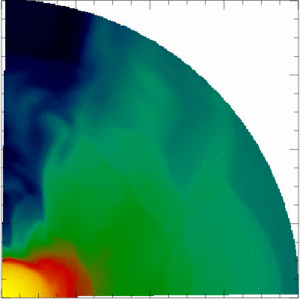| MPA-HOMEPAGE |
|
 |
Nonlinear Axisymmetric Pulsations of Rotating Relativistic Stars | ||
|
|
 Go to:
|
H. Dimmelmeier N. Stergioulas ( J.A. Font (  Introduction:
Introduction:
Pulsations of rotating neutron stars could be excited in a number of astrophysical scenarios, such as rotating core collapse, accretion-induced collapse, core quakes due to a large phase-transition in the equation of state, or hypermassive neutron star formation in a binary neutron star merger. These pulsations are a potential source of detectable high-frequency gravitational waves. While for nonrotating stars the frequencies of normal modes can be computed with perturbative methods, there exist no accurate frequency determinations for rapidly rotating stars to date. Most existing computations of oscillation modes in rapidly rotating relativistic stars use the Cowling approximation [Font, et al., 2001, Stergioulas, et al., 2004], where the evolution of the gravitational field is suppressed. As previous simulations have indicated, the pulsation frequency values computed in this approximation can overestimate the correct values by a factor of up to 2! In our new work [Dimmelmeier, et al., 2006] we were able to perform an accurate determination of several axisymmetric pulsation modes of rotating stars in general relativity.
Our study extends the results presented by
[Stergioulas, et al., 2004]
(which were obtained in the Cowling approximation) by incorporating
the dynamics of the gravitational field in the evolutions. This is
done by using the Isenberg--Wilson--Mathews approximation of general
relativity, also known as the conformally flat condition (CFC)
[Wilson, et al., 1996].
As we have shown in previous work
[Dimmelmeier, et al., 2001,
Dimmelmeier, et al., 2002a,
Dimmelmeier, et al., 2002b,
Dimmelmeier, et al., 2005], the approximation works well
for rotating neutron star models (the scenario investigated here)
as well as in highly dynamical situations like
For small pulsation amplitudes we have identifies several modes, including
the lowest-order l = 0, 2, and 4 axisymmetric modes as well as
several axisymmetric inertial modes. The pulsations are studied along
the same sequences of uniformly and differentially rotating
neutron star models as in
[Stergioulas, et al., 2004]. Differential
rotation significantly shifts mode frequencies to smaller values,
increasing the likelihood of detection by current gravitational wave
interferometric detectors
(like In [Stergioulas, et al., 2004] a new non-linear damping mechanism for non-linear pulsations was found to operate in uniformly rotating models that are near the mass shedding limit. The damping of pulsations is due to mass shedding, when fluid elements near the equator become unbound due to the radial component of the velocity perturbation. This mass-shedding-induced damping could have severe consequences for, e.g., the f-mode gravitational-wave driven CFS instability, which grows on a secular time-scale. In our new work we have found that while the actual mass-shedding-induced damping does not occur on dynamical time-scales (as in the Cowling approximation) it is still present on secular time-scales, so that a detailed comparison to the f-mode growth rate is required in order to determine the outcome of the f-mode instability. We have also investigated the gravitational wave signals emitted by the linear modes F, H1, 2f, and 2p1 for a slowly rotating neutron star model. In order to estimate the prospects for detectability of the signal by interferometric detectors, we have computed the signal frequency and amplitude for the sensitivity of several detectors. We infer that for a pulsation amplitude of the stellar central density of 5% a gravitational wave signal from the investigated modes is measurable by current detectors, if the signal is integrated over a time of at least 20 ms and the source is located in our Galaxy.
A summary of important quantities of the neutron star models and the
frequencies of selected linear pulsation modes are given in several
A more detailed overview about this project and the results can be found in a color slide presentation:
|